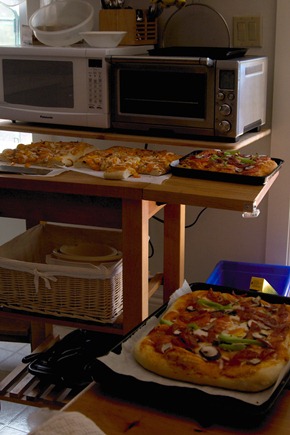We like preparing our meals in bulk. Buying groceries and cooking up a storm on the weekends means that we can grab quick and healthy lunches from the fridge or freezer, enjoy a variety of dinners during the week, and focus on other things that we want to do in the evenings.
I was looking for a menu planner and grocery list maker to help us plan and execute these batch cooking sessions more efficiently. In particular, I wanted something that could sort the ingredients for preparation, too. I like preparing ingredients for all the different recipes before I start cooking. If several recipes call for garlic, I might as well chop a lot of garlic in one session instead of breaking out the chopping board for each recipe.
I tried several menu planning and grocery list apps, but I wasn’t happy with any of the ones I came across. I like using Emacs for as much as possible, so I figured that I should give it a try. Here’s what I did and how it worked out.
I created an Org file for my recipes. In this plain-text outline, I created sections for my plan, shopping list, preparation tasks, and recipes. Under recipes, I created TODO items and scheduled them. Here’s an example entry:
** TODO Colorful bulgur salad
SCHEDULED: <2012-06-19 Tue>
http://allrecipes.com/recipe/colorful-bulgur-salad/
| 1/2 cup | bulgur wheat | | [[Colorful bulgur salad]] |
| 1/2 cup | chicken broth | | [[Colorful bulgur salad]] |
| 1 small | cucumber | seeded and chopped | [[Colorful bulgur salad]] |
| 1 | tomato | chopped | [[Colorful bulgur salad]] |
| 1 | carrot | shredded | [[Colorful bulgur salad]] |
| 3 | green onions | thinly sliced | [[Colorful bulgur salad]] |
| 3 tablespoons | fresh lime juice | | [[Colorful bulgur salad]] |
| 3/4 tablespoon | chili powder | | [[Colorful bulgur salad]] |
| 1 pinch | garlic powder | | [[Colorful bulgur salad]] |
I reformatted each recipe to fit this format, with columns for quantity, type, preparation, and recipe link. After I chose several recipes, I copied the ingredient lists into my preparation section and my shopping section. In the shopping section, I deleted the lines for ingredients I already had or could skip. I used org-table-sort-lines to sort the table by the second column, which gave me this list:
| 1 bag | chicken legs and thighs | | [[Arroz caldo]] |
| 2 small or 1 large | cucumber | chopped | [[Gazpacho]] |
| 1 small | cucumber | seeded and chopped | [[Colorful bulgur salad]] |
| 3 | green onions | thinly sliced | [[Colorful bulgur salad]] |
| 1 | red onion | cut into 1" pieces | [[Shrimp kebabs]] |
| 1 pound | shrimp | peeled and deveined | [[Shrimp kebabs]] |
| 6 - 8 | tomatoes | chopped (Roma or plum are best; Don't lose the juice!) | [[Gazpacho]] |
| 1 | zucchini | seeded and cut into 1" pieces | [[Shrimp kebabs]] |
It wasn’t sorted by aisle, but that was easy to do when I copied the list onto a recycled envelope. If I find myself using this a lot, I might write an Emacs Lisp function to gather the tables and sort the rows by aisle.
Anyway, shopping list in hand, we picked up our groceries in about ten minutes last Saturday. The next day, I looked at my prep list:
| | basil | chopped | [[Gazpacho]] |
| 1/2 cup | bulgur wheat | | [[Colorful bulgur salad]] |
| 1 tbsp | butter | | [[Bubble and squeak]] |
| 2 tbsp | canola or peanut oil | | [[Teriyaki tofu]] |
| 1 | carrot | shredded | [[Colorful bulgur salad]] |
| 1/2 cup | chicken broth | | [[Colorful bulgur salad]] |
| 1 bag | chicken legs and thighs | separated | [[Arroz caldo]] |
| 3/4 tablespoon | chili powder | | [[Colorful bulgur salad]] |
| 1/4 cup | cider vinegar | | [[Teriyaki tofu]] |
| 1 can | corned beef | | [[Bubble and squeak]] |
| 3 tbsp | cornstarch | | [[Teriyaki tofu]] |
| 1 tbsp | cornstarch | | [[Teriyaki tofu]] |
| 1 small | cucumber | seeded and chopped | [[Colorful bulgur salad]] |
| 2 small or 1 large | cucumber | chopped | [[Gazpacho]] |
| 1 lb | firm tofu | drained | [[Teriyaki tofu]] |
| | fresh ground black pepper | | [[Gazpacho]] |
| 3 tablespoons | fresh lime juice | | [[Colorful bulgur salad]] |
| 3 cloves | garlic | chopped | [[Arroz caldo]] |
| 1 clove | garlic | minced | [[Teriyaki tofu]] |
| 2 cloves | garlic | diced | [[Gazpacho]] |
| 1 tablespoon | garlic | minced | [[Shrimp kebabs]] |
| 1 pinch | garlic powder | | [[Colorful bulgur salad]] |
| | glutinous rice | | [[Arroz caldo]] |
| 1 tsp ginger | grated or minced | | [[Teriyaki tofu]] |
| | green onions | chopped | [[Arroz caldo]] |
| 3 | green onions | thinly sliced | [[Colorful bulgur salad]] |
| | leftover vegetables (cabbage, carrots) | | [[Bubble and squeak]] |
| 1 | lemon | juice of | [[Gazpacho]] |
| 2 teaspoons | lemon juice | | [[Shrimp kebabs]] |
| 1/4 cup | olive oil | | [[Shrimp kebabs]] |
| 1 | onion | thinly sliced | [[Bubble and squeak]] |
| 1/2 large | onion | chopped finely (red is a nice alternative) | [[Gazpacho]] |
| 1/2 large | onion | chopped in 1/4 inch chunks | [[Gazpacho]] |
| pinch | parsley | finely chopped | [[Shrimp kebabs]] |
| 1/4 tsp | pepper | | [[Teriyaki tofu]] |
| 1/4 teaspoon | pepper | | [[Shrimp kebabs]] |
| 3 cups | potatoes | mashed | [[Bubble and squeak]] |
| 1 | red onion | cut into 1" pieces | [[Shrimp kebabs]] |
| | salt (preferably sea salt) | | [[Gazpacho]] |
| 1 tsp | sesame oil | | [[Teriyaki tofu]] |
| 1 pound | shrimp | peeled and deveined | [[Shrimp kebabs]] |
| | soy sauce | | [[Arroz caldo]] |
| 1/2 cup | soy sauce | | [[Teriyaki tofu]] |
| 1 | tomato | chopped | [[Colorful bulgur salad]] |
| 6 - 8 | tomatoes | chopped (Roma or plum are best; Don't lose the juice!) | [[Gazpacho]] |
| | virgin olive oil | | [[Gazpacho]] |
| 1/2 cup | white sugar | | [[Teriyaki tofu]] |
| 1 | zucchini | seeded and cut into 1" pieces | [[Shrimp kebabs]] |
Sorting the list by ingredient made it easy to go through the groups of ingredients and prepare them all, and the links to the recipes made it easy to look up next steps. I planned the order of doing them. First, I prepared the bulgur wheat because that needed an hour to soak. I saved the chicken legs for the end because they were messy, and I saved the onions for later as well because they always make me cry. I cut and chopped and food-processed my way through stacks of vegetables, covering the kitchen table with bowls.
With all the ingredients prepared, I washed the utensils and put things away. That freed up counter space for cooking. I reordered the recipes so that it was easy to see what to work on next, and I started cooking.
The entire cooking sprint took me 5 hours and 42 minutes, which was a lot of cooking but well worth it. With that and the meals we’d prepared over the past few weeks, our freezer’s stuffed to capacity. Four tidy stacks of identical food containers, then odds and ends crammed into the spaces! By golly.
I really liked planning this batch cooking session in Emacs. Org tables made things easy to sort, and the hyperlinks let me look up recipes and notes quickly.
I could probably make this even better by:
- rigging up my foot pedal to scroll up and down through food.org
- copying in the recipe steps so that I can take advantage of that scrolling
- figuring out how to use Org Babel to automatically compile the ingredient tables for the named recipes
Now if only someone would write M-x wash-dishes…






 When we started cooking in bulk, we standardized on the Rubbermaid Takealongs Sandwich Keepers (7F58RDFCLR). The inexpensive containers were the right size for lunches. They stacked and nested well, too. I picked up 24 or so over several shopping trips, enough to handle a couple of weeks of lunches for W- and me.
When we started cooking in bulk, we standardized on the Rubbermaid Takealongs Sandwich Keepers (7F58RDFCLR). The inexpensive containers were the right size for lunches. They stacked and nested well, too. I picked up 24 or so over several shopping trips, enough to handle a couple of weeks of lunches for W- and me.